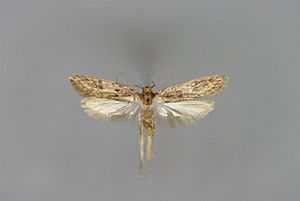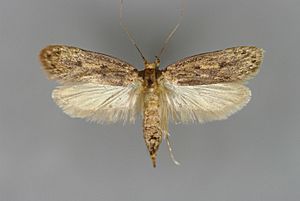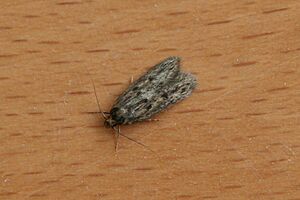Brown house moth facts for kids
Quick facts for kids Brown house moth |
|
|---|---|
 |
|
| Male | |
 |
|
| Female | |
| Scientific classification | |
| Kingdom: | |
| Phylum: | |
| Class: | |
| Order: | |
| Family: |
Oecophoridae
|
| Genus: |
Hofmannophila
Spuler, 1910
|
| Species: |
H. pseudospretella
|
| Binomial name | |
| Hofmannophila pseudospretella (Stainton, 1849)
|
|
The brown house moth (scientific name: Hofmannophila pseudospretella) is a common type of moth. It belongs to a group of moths called "concealer moths." This moth is the only known species in its specific group, or genus, called Hofmannophila.
Contents
Where Do Brown House Moths Live?
This moth originally came from Asia. In the 1840s, it traveled to Europe and other parts of the world. Now, you can find brown house moths almost everywhere! They are very common in places like Britain.
These moths often live near people. They can be found inside houses and other buildings. Sometimes, you might also find them outside. For example, their young (called larvae) can live in bird nests, eating things like bird droppings and other natural waste.
Why Are Brown House Moths Pests?
Brown house moths are considered a serious pest. This is because their larvae (the caterpillar stage) can cause a lot of damage. They eat many different things found in homes and businesses.
What Do They Eat?
Brown house moth larvae like to eat stored foods such as cereals, dried fruit, and seeds. They also munch on clothes and furniture fabric. Other things they have been known to eat include fur, wood floors, book bindings, and even wine bottle corks!
How Do They Cause Damage?
These larvae have a special ability to break down keratin. Keratin is a tough protein found in things like wool, hair, and feathers. They can do this because of special bacteria in their stomachs. This makes them very destructive.
They can even bite through synthetic carpet fibers. They do this to build their cocoons for pupation. Because they don't usually eat these fibers, many regular moth-proofing sprays don't stop them.
What Do Brown House Moths Look Like?
Brown house moths change their appearance as they grow. They go through four main stages: egg, larva, pupa, and adult.
Larvae (Caterpillars)
Young brown house moths, called larvae, have a brown head. Their bodies are a dull white color and look a bit see-through. Their legs are pale yellowish-brown. Since their bodies are see-through, their color might change depending on what they have eaten!
Adult Moths
Adult brown house moths have pale yellowish-brown front wings. These wings have dark brown patches. Each front wing has a noticeable dark spot in the middle. Their back wings are brownish-grey. The head, chest, and body of the moth are dark grey-brown. They have simple, thin antennae. These moths can have a wingspan of about 15 to 26 millimeters (about 0.6 to 1 inch).
Life Cycle of the Brown House Moth
Female brown house moths can lay up to 260 eggs during their lifetime. Some larger females might even lay 400 to 500 eggs! The eggs are laid either one by one or in small groups.
Eggs and Larvae
If conditions are good, the eggs hatch into larvae in about 10 to 20 days. The larvae are active from June to April. During this time, they spin silky tubes using the food they eat. They also leave behind small droppings and silk threads.
Larvae need a fairly humid (damp) environment to grow properly. Warmer temperatures can make their pupal stage shorter. While they can survive tough conditions by resting, very cold frost can kill them. Before they turn into pupae, the larvae leave their feeding spot. They might travel for a few days to find a safe place to build their cocoon.
Adult Moths
Adult moths are usually active from May to September. However, if they live in heated buildings, you might see them all year round. They are often drawn to light and can fly at any time of the year.
A tiny mite called Cheyletus eruditus is known to hunt and eat these moths.
Images for kids



